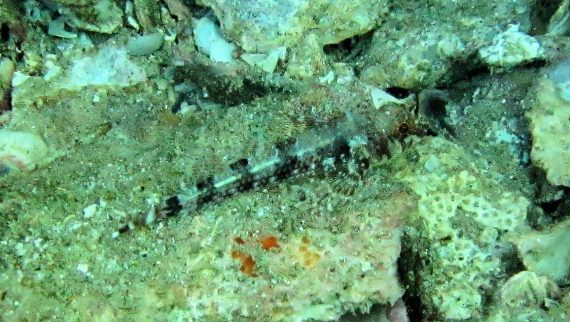Flag Triplefin, Enneanectes reticulatus
 Flag Triplefin, Enneanectes reticulatus. Underwater photograph taken in the greater Los Cabos area, Baja California Sur, October 2019. Photograph courtesy of Bob Hillis, Ivins, Utah.
Flag Triplefin, Enneanectes reticulatus. Underwater photograph taken in the greater Los Cabos area, Baja California Sur, October 2019. Photograph courtesy of Bob Hillis, Ivins, Utah.
The Flag Triplefin, Enneanectes reticulatus, is a member of the Triplefin or Tripterygiidae Family, that is also known at the Network Triplefin and the Reticulated Triplefin and in Mexico as tres aletas bandera. Its common name stems from the division of its dorsal fin into three parts, two of which have spines. Globally, there are one hundred forty-five members in the Tripterygiidae Family placed in thirty genera with eighteen species in the genus Enneanectes of which eight are found in Mexican waters, three in the Atlantic and five in the Pacific Ocean.
The Flag Triplefin has a short robust body with a large head that has a short, broad, simple cirri over the eye. They are an overall whitish to tan in color. They are dimorphic with the females having 4 slightly diagonal brown bars on the sides, a black band around the base of the caudal fin and scale margins that are dusky and impart a network pattern. The males have a reddish head, 4 black bars on the body and a black caudal fin with 2 white bars. Their anal fin has 2 spines and 17 to 20 rays; they have three dorsal fins the first with 3 spines, the second with 9 to 11 spines and the third with 9 to 11 rays; and the pelvic fins are completely separate. They are covered with medium to large rough scales. They have two straight lateral lines with slightly overlapping sections.
The Flag Triplefin is a demersal species that is common within the shall rocky intertidal zone to depths up to 5 m (16 feet). They reach a maximum of 6.9 cm (2.7 inches) in length. They consume algae and small invertebrates. Reproduction is oviparous with hemispherical eggs that attach themselves to the substrate via sticky threads. The larvae are planktonic and are found in shallow in-shore waters. The Flag Triplefin is poorly studied with very limited information available about their lifestyle and behavioral patterns including specific details on age, growth, longevity, movement patterns, diet, habitat use, and reproduction.
The Flag Triplefin is a resident of Mexican waters of the Pacific Ocean but has a limited distribution being found along the entire West Coast of Baja and throughout the Sea of Cortez. They are one of the most abundant reef residents of the Sea of Cortez.
The Axoclinus storeyae Cortez Triplefin is most likely confused with the Carmine Triplefin, Axoclinus storeyae (3 red-brown bars and 4 rows of white spots), the Cortez Triplefin, Axoclinus nigricaudus (5 oblique dark bars mid-flank) and the Delicate Triplefin, Enneanectes carminalis (transparent caudal fin).
From a conservation perspective, the Flag Triplefin is currently considered to be of Least Concern with stable, widely distributed populations. They are small in stature, of limited interest to most, and seldom seen by humans.